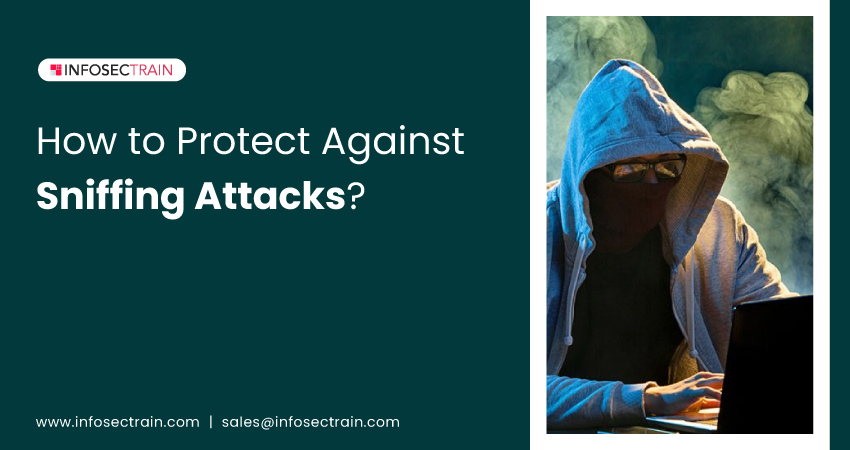How to Protect Against Sniffing Attacks?

Table of Contents
Introduction to Sniffing Attacks
Types of Sniffing Attacks
How to Prevent Sniffing Attacks?
Introduction to Sniffing Attacks
Sniffing attacks, also known as network sniffing or packet sniffing attacks, are malicious activities where an attacker intercepts and captures network traffic to gain unauthorized access to sensitive information. These attacks are typically carried out using specialized software tools known as packet sniffers or network analyzers.
In this attack, the attacker places their device in a place where it can monitor and capture network packets. It can be done by connecting to a switch or router on a wired network or by capturing wireless signals in the case of wireless networks. The attacker aims to capture and analyze the data packets transmitted over a network, potentially exposing unencrypted information.
Types of Sniffing Attacks
Below are the two common types of sniffing attacks:
- Passive Sniffing: In passive sniffing attacks, the attacker primarily focuses on intercepting and capturing network traffic without actively altering or disrupting it.
- Active Sniffing: In active sniffing attacks, the attacker not only intercepts the network traffic but also injects or modifies the packets. It allows attackers to manipulate the data transmitted across the network and potentially perform more sophisticated attacks.
How to Prevent Sniffing Attacks?
To safeguard yourself against sniffing attacks, consider following these steps:
- Use Encrypted Connections: Use encryption protocols such as HTTPS for web browsing, SSH for remote connections, SSL/TLS for email services, and VPNs (Virtual Private Networks) connections to secure your internet traffic. Encryption assures that the data transmitted between your device and the destination is encrypted, making it difficult for sniffers to decipher.
- Use Secure Networks: Be cautious when connecting to public Wi-Fi networks, such as cafes or airports, as they are often unsecured and prone to sniffing attacks. Instead, use trusted and secure networks, such as your home or work network, to ensure it is protected with a strong password and encrypted with WPA2 or WPA3 encryption. Also, consider using a VPN to encrypt your traffic when connected to public networks.
- Keep Devices and Software Updated: Regularly update your operating system, web browsers, and applications. Updates frequently include security patches that address vulnerabilities exploitable by sniffing attacks.
- Use Firewall Protection: Enable and configure a firewall on your system or network router. Firewalls monitor and control inbound and outbound network traffic, providing an extra layer of security against unauthorized access.
- Beware of Malicious Emails and Attachments: Be wary of opening email attachments or clicking on suspicious links, as they can be used to deliver malware that could facilitate sniffing activities. Always verify the sender’s identity and exercise caution before downloading or executing any files.
- Use Strong, Unique Passwords: Ensure you have strong, unique passwords for all your online accounts. Sniffers may attempt to capture login credentials. For enhanced security, it is suggested to use a password manager that can create and save robust and secure passwords.
- Implement Two-factor Authentication (2FA): Enable two-factor authentication wherever possible. 2FA incorporates an extra layer of protection by mandating a second verification step, such as a unique code sent to your phone, along with your password.
- Monitor Your Network: Regularly monitor your network for any suspicious activities or unauthorized devices connected to it. Use network monitoring tools to detect any anomalies or potential sniffing attempts.
Related blogs:
- Types of Network Security Attacks
- Common Cyber Attacks and Ways to Prevent Them
- How to Protect Organizations from Cyberattacks?
- How To Prevent Zero-Day Attacks?
How can InfosecTrain help?
To learn more about sniffing, you can enroll in InfosecTrain‘s Certified Ethical Hacker (CEH) certification training course. In this course, you will learn about packet-sniffing techniques and how to use them to identify network vulnerabilities, which will further help in understanding how to protect against sniffing attacks. We will provide you with practical exercises using realistic-looking simulated targets to develop your skills to perform network sniffing using various sniffing tools.
TRAINING CALENDAR of Upcoming Batches For CEH v13
| Start Date | End Date | Start - End Time | Batch Type | Training Mode | Batch Status | |
|---|---|---|---|---|---|---|
| 11-May-2025 | 28-Jun-2025 | 09:00 - 13:00 IST | Weekend | Online | [ Open ] | |
| 31-May-2025 | 06-Jul-2025 | 19:00 - 23:00 IST | Weekend | Online | [ Open ] | |
| 07-Jun-2025 | 13-Jul-2025 | 09:00 - 13:00 IST | Weekend | Online | [ Open ] | |
| 21-Jun-2025 | 27-Jul-2025 | 19:00 - 23:00 IST | Weekend | Online | [ Open ] |







 1800-843-7890 (India)
1800-843-7890 (India)